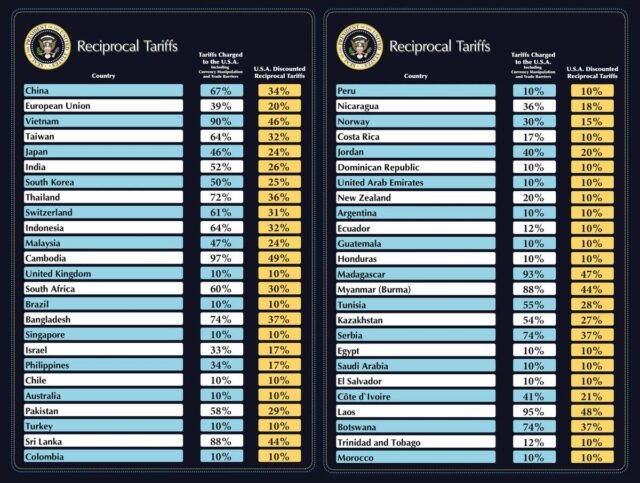Trump’s Reciprocal Tariffs Shake Global Markets: A New Trade Era Unfolds

In a dramatic move that has sent shockwaves through global trade circles, the U.S. President Donald Trump announced the imposition of reciprocal tariffs on all imported goods. Effective from April 5, a baseline tariff of 10% will be levied on every product entering the United States, with even steeper rates applied to nations imposing high duties on American exports. This marks a significant shift in trade policies, designed to combat what Trump has long termed as “unfair trade practices.”
Leveling the Playing Field or Stoking Trade Fires?
The policy aims to counteract lopsided trade imbalances by mirroring tariffs imposed on American products. Trump, in his characteristic no-holds-barred style, declared, “Reciprocal… that means they do it to us, and we do it to them.” This policy directly targets countries such as China, which slaps a hefty 67% tariff on U.S. imports. In response, Chinese goods will now be subject to a 34% levy in addition to an existing 20% duty, making the total tariff a whopping 54%.
Other key trading partners, including the United Kingdom and Brazil, which currently charge a 10% tariff on American goods, will now face a 10% duty on their exports to the U.S. The policy also takes into account hidden trade barriers, such as value-added taxes (VAT) in the European Union, currency manipulation, and regulatory roadblocks that allegedly disadvantage American manufacturers.
Markets in Turmoil: Investors Hit the Panic Button
Financial markets reacted with extreme volatility as news of the tariff policy spread. The announcement, made from the iconic Rose Garden, sent U.S. stock futures into a tailspin. The S&P 500 tumbled 1.6%, while Dow Futures saw an unprecedented plunge of over 1,000 points in after-hours trading. Wall Street, which had earlier shown resilience, found itself wobbling under the weight of trade war fears.
Technology stocks, which heavily rely on global supply chains, bore the brunt of investor panic. Meanwhile, the price of gold surged to new highs as jittery investors rushed toward safe-haven assets, a classic response to economic uncertainty.
International Fallout: A Brewing Trade War?
Trump’s tariff plan has not only rattled domestic markets but has also set the stage for a global trade showdown. Key Asian economies, including China, Japan, and South Korea, have hinted at a coordinated response. Reports suggest that these nations are exploring collective retaliatory measures against U.S. tariffs. The European Union, led by President Ursula von der Leyen, has issued a stern warning, stating that while the EU prefers diplomacy, it has a robust counter-strategy in place should negotiations fail.
The reverberations of this policy were felt across international financial centers. Japan’s Nikkei 225 and South Korea’s KOSPI saw steep declines of over 4% in early trading, mirroring the bloodbath on Wall Street. Meanwhile, the Chinese yuan and Thai baht weakened amid fears of rising inflation and economic slowdown triggered by the tariff war.
India Caught in the Crossfire?
India, often caught in the whirlwind of global trade disputes, has not been spared. The White House has announced a broad-based tariff of 26% on Indian goods, citing an alleged 52% trade barrier imposed by India on U.S. products. This new duty is in addition to the blanket 10% tariff on all imports, which further complicates India’s export landscape.
GIFT Nifty, the indicator for Indian stock markets, tumbled over 1% in early morning trade, hinting at a weak start for domestic equities. Indian businesses that rely on exports to the U.S. will likely face higher costs, potentially impacting competitiveness and profit margins.
Below is the list of countries with tariffs charging to U.S and Discounted Reciprocal Tariffs Charged by U.S:

Looking Ahead: The Future of Global Trade
While Trump and his administration argue that these tariffs will boost domestic manufacturing and reduce trade deficits, economists and industry experts are divided. Some believe that higher tariffs will encourage companies to shift production back to the U.S., leading to job creation and industrial revival. Others warn that this move could backfire, as retaliatory tariffs from trading partners may escalate into a full-blown trade war, hurting businesses and consumers alike.
As the April deadlines approach, the world watches with bated breath. Will this new policy truly pave the way for American economic resurgence, or will it unleash a fresh wave of economic instability? Either way, one thing is clear—global trade will never be the same again.
Disclaimer: The views and investment insights provided here are based on publicly available information and do not constitute financial advice. Readers are advised to conduct their own research or consult certified financial experts before making investment decisions.

